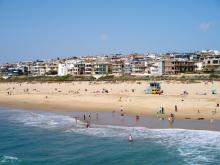
Fast, affordable Internet access for all.

The South Bay Cities Council of Governments (SBCCOG), a group of 16 cities, has joined with Los Angeles County and will work with American Dark Fiber to develop a fiber optic network throughout the region.
Unclogging the Streets, Now and Tomorrow
The public-private partnership aims to develop infrastructure to improve local connectivity, but another key goal is real-time transportation and traffic control. With better traffic synchronization that involves all the participating communities, traveling from one town to the next can be seamless. The SBCCOG is also considering a future that will include autonomous vehicles and seeking the connectivity needed to manage driverless cars.
In addition to applications that directly impact traffic on the road, the SBCCOG is considering ways to reduce the number of car trips. They want to invest in a fiber network to enable applications such as smart city halls — allowing folks to access municipal services from home — telemedicine, distance education, and telecommuting. By reducing the need for people to travel with their vehicles, the sixteen communities that belong in the SBCCOG also aim to reduce pollution.
Partnership
The consultant hired by SBCCOG in 2016 to develop a Master Plan recommended that the organization pursue a public-private partnership. American Dark Fiber (ADF) will build the network, the city recently announced [PDF]. SBCCOG received $4.4 million in funding from the Los Angeles County Metropolitan Transportation Authority and $1.2 million from the State of California to build the fiber ring. The network is the foundation for the region's master plan, which they also developed with consulting firm Magellan Advisors.
Approximately 100 miles of fiber will connect all city halls, at least two data centers, and approximately fifty other buildings identified as “critical” by the SBCCOG. The network will belong to ADF, but Jory Wolf, Vice President of Digital Innovation at Magellan Advisors, says that communities that belong to SBCCOG will be able to opt out at various intervals of the contract.
Public ownership of the infrastructure creates a situation where local governments have more control over how that infrastructure is used and secures which ISPs offer services to the community. In this case, any of the members of the SBCCOG would need to work with an alternate provider for connectivity, if they were no longer happy with ADF. The region, however, already contains more fiber than many others, according to Jory, so if a city decided to part with ADF and build its own broadband infrastructure, it would likely have access to some existing fiber from the start.
Listen to our November 2018 interview with Jory for the Community Broadband Bits podcast, in which he talks about this project and his work with Ventura County:
Image of Manhattan Beach courtesy of See South Bay.
